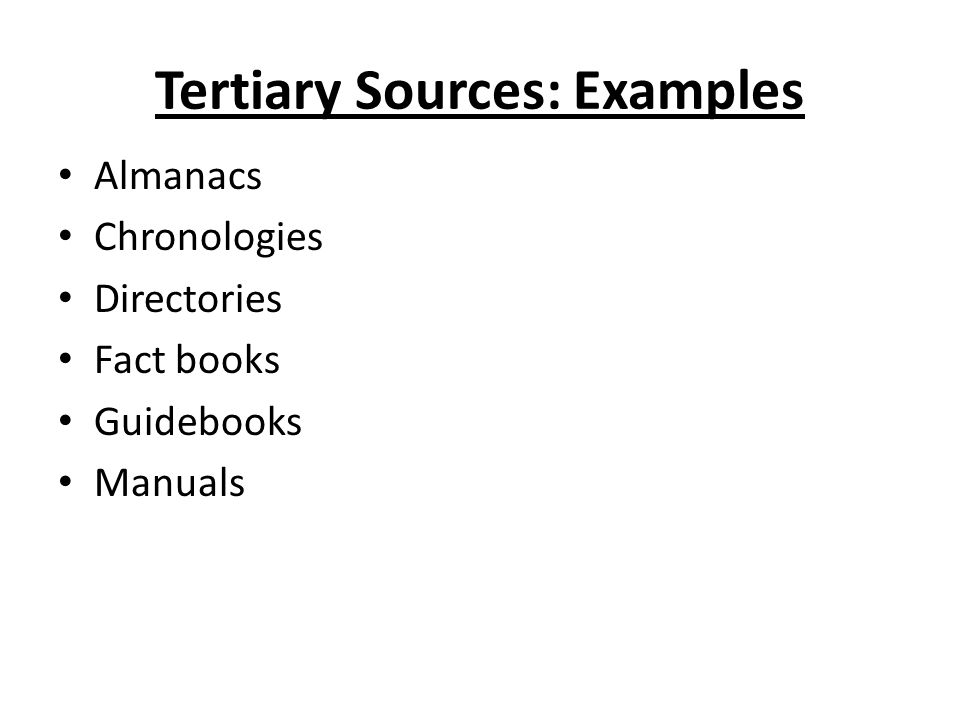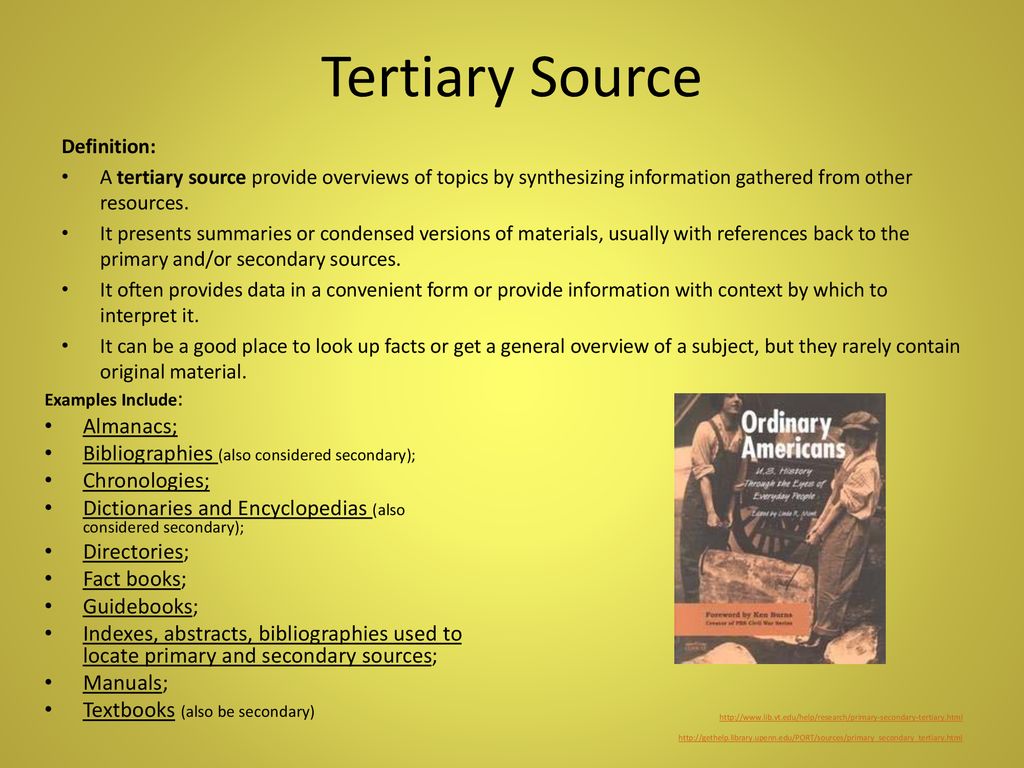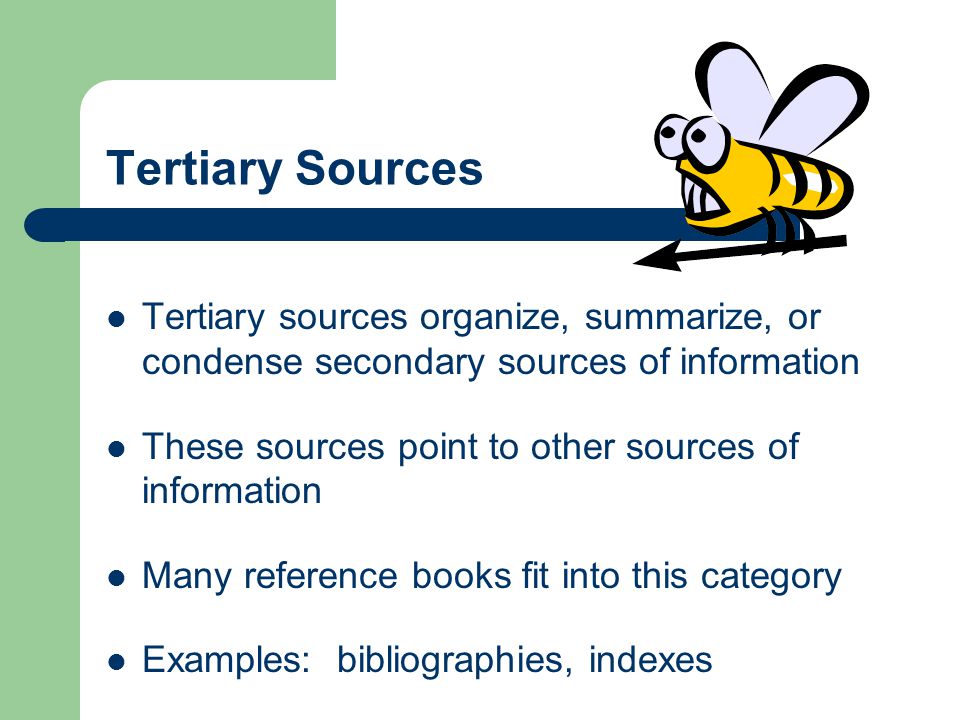TERTIARY SOURCES
Tertiary sources are an essential component of the information hierarchy used to categorize and evaluate different types of information sources based on their level of originality and depth. Understanding and properly using tertiary sources can be valuable for research, fact-checking, and gaining an overview of a particular topic. Let's define and explore how to use tertiary sources effectively:
Tertiary sources are information resources that compile, summarize, or index information from primary and secondary sources. They do not present original research but rather provide an overview or analysis of existing information. Tertiary sources are typically created for the purpose of presenting information in a more accessible and organized manner, making it easier for readers to grasp a broad subject or find specific facts quickly.
Examples of Tertiary Sources:

Encyclopedias: General encyclopedias like Wikipedia or specialized encyclopedias on specific subjects are classic examples of tertiary sources. They summarize information from various primary and secondary sources to provide a broad understanding of a topic.
Almanacs: These annual publications contain a wealth of information on various subjects, such as statistical data, historical events, and general knowledge, compiled from different sources.
Dictionaries: While primary dictionaries focus on defining words, some specialized dictionaries also provide background information on terms or concepts.
Textbooks: While not exclusively tertiary sources, textbooks often include synthesized information from multiple sources to provide an educational overview of a subject.
Guidebooks: Travel guidebooks, for example, collect information from various sources to offer tips and insights about destinations.
How to Use Tertiary Sources:
Using tertiary sources for a quick overview is a valuable strategy when delving into a new or unfamiliar subject. When confronted with a complex topic, tertiary sources, such as encyclopedias or specialized reference books, serve as an accessible entry point into the subject matter. By consulting these sources, researchers can efficiently gain a broad understanding of the topic's key concepts, historical context, and significant figures. This initial exposure to the subject helps lay a solid foundation, making it easier to identify relevant keywords and themes for further investigation. Tertiary sources act as a roadmap, guiding researchers through the vast landscape of information and enabling them to narrow their focus and approach primary and secondary sources with a clearer direction. However, it is essential to remember that these sources provide generalized information, and for more in-depth analysis and authoritative evidence, one should turn to primary and secondary sources. Nevertheless, leveraging tertiary sources for a quick overview is an indispensable step in the research process, providing context and aiding in the pursuit of comprehensive knowledge on any given subject.

Keyword identification is a crucial aspect of utilizing tertiary sources effectively for research. When embarking on a new research project or seeking information on an unfamiliar topic, tertiary sources like encyclopedias and specialized dictionaries can serve as valuable starting points. By perusing these sources, researchers can identify essential keywords and key concepts related to the subject matter. Tertiary sources often present information in a clear and concise manner, highlighting the most significant aspects of a topic. As researchers skim through these sources, they can take note of the recurring terms, names, events, or ideas mentioned, which can serve as the foundation for more focused and in-depth searches using primary and secondary sources. Furthermore, the process of keyword identification helps researchers refine their research questions and construct more effective search queries when delving into more specialized literature. While tertiary sources provide a convenient overview, it is essential to corroborate the identified keywords with primary and secondary sources to ensure accuracy and depth in the subsequent research process. By harnessing the power of keyword identification through tertiary sources, researchers can streamline their information-seeking journey and uncover a wealth of relevant and reliable sources for comprehensive analysis.
- Gathering Background Information:
Gathering background information is a critical step in the research process, and tertiary sources play a pivotal role in this regard. When embarking on a new topic or subject of study, tertiary sources offer an excellent starting point to gain an overview of the field. Encyclopedias, for instance, provide concise and organized summaries of key concepts, historical developments, and influential figures related to the subject. By consulting these sources, researchers can quickly familiarize themselves with the fundamental aspects of the topic they wish to explore.
Tertiary sources are especially helpful for orienting oneself in complex or unfamiliar subjects. They offer a broad perspective, giving context to the research and helping identify potential avenues for further investigation. Additionally, these sources often present information in a reader-friendly manner, using accessible language that simplifies complex ideas. This approach enables researchers, particularly those new to the field, to grasp the essential elements and understand the broader context before delving into more specialized primary and secondary sources.

Moreover, tertiary sources aid in narrowing down the focus of research. By skimming through the contents of an encyclopedia or a specialized guidebook, researchers can identify relevant keywords, key events, and influential works related to the topic. This valuable insight aids in structuring subsequent research and crafting specific research questions.
While tertiary sources offer an efficient way to gather background information, researchers must exercise caution and critically evaluate the reliability of the sources. Not all tertiary sources are created equal, and some may contain inaccuracies or outdated information. To mitigate this risk, it is essential to cross-reference information from multiple reputable tertiary sources and corroborate it with primary or secondary sources that provide more rigorous and verified data. By employing a balanced approach and combining tertiary sources with other reliable information, researchers can lay a strong foundation for their study and embark on a more informed and fruitful research journey..
Fact-checking is a crucial aspect of information evaluation, and tertiary sources can play a role in this process. When fact-checking, tertiary sources can be utilized as a preliminary step to verify specific details or claims. However, it's essential to approach this with caution and critical thinking. Tertiary sources, such as encyclopedias or specialized guides, can provide a quick snapshot of information, but their reliability is contingent on the accuracy of their underlying primary and secondary sources.
To effectively use tertiary sources for fact-checking, it is advisable to cross-reference the information with multiple reputable and reliable primary or secondary sources. By doing so, you can validate the accuracy and legitimacy of the data presented. Additionally, when citing a tertiary source in your research or discussions, always check if they provide references or citations to the original sources they relied upon. This allows you to trace the information back to its origin and ascertain its veracity.
However, relying solely on tertiary sources for fact-checking is not advisable, as they lack the depth and thoroughness of primary and even secondary sources. Instead, view tertiary sources as a starting point to gain a general understanding of a topic, identify relevant keywords, and get an overview of the subject. As you progress in your research, transition to primary and secondary sources for more comprehensive and accurate information.
In conclusion, while tertiary sources can offer a convenient entry point for fact-checking and research, they should be used judiciously and in conjunction with higher-quality sources. Maintaining a critical eye and seeking information from multiple reliable sources will ensure the accuracy and integrity of your fact-checking endeavors.
Identifying references within tertiary sources is a crucial skill that can greatly enhance the effectiveness of one's research. When consulting tertiary sources, such as encyclopedias or specialized guides, it is essential to pay close attention to the citations or references provided by the authors. These references can serve as valuable gateways to more authoritative and in-depth information available in primary and secondary sources. By examining the cited works, researchers can trace the origin of the information presented in the tertiary source and validate its accuracy and reliability. Moreover, these references can lead to a network of related sources, expanding the breadth and depth of research. This approach not only ensures the credibility of the information but also empowers researchers to explore the original studies, analyses, or data behind the summarized content. By using tertiary sources to identify references and then delving into the cited materials, researchers can build a solid foundation for their work, strengthening the overall credibility and quality of their research findings.
Caution and Evaluation:

While tertiary sources can be useful, it's crucial to use them cautiously and evaluate their reliability. Some points to consider:
Accuracy: Verify the information from multiple reputable tertiary sources or find primary/secondary sources that support the information presented.
Credibility: Check the credibility of the publisher or author of the tertiary source to ensure they have expertise in the subject.
Currency: Be aware of the publication date. Some information may become outdated, especially in rapidly changing fields.
Avoid Sole Reliance: Do not solely rely on tertiary sources for research; instead, use them as a starting point to explore primary and secondary sources for more in-depth information.
By understanding what tertiary sources are and how to use them effectively, researchers can enhance their ability to gather reliable information and gain a comprehensive understanding of various subjects.
